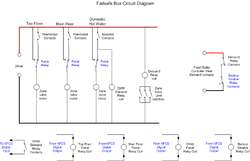Since I don't trust computers, I've spent a fair amount of time designing my system to 'fail safe' - that is, to be able to provide heat even if the controller fails. My current solution is WAY too complicated, and I've looked at this problem in light of my gradual progress towards a salable version of the NoFossil Control System (NFCS).
Here's what I'm thinking: Any system that has a computer involved should be designed so that backup heat works properly even if the computer fails or isn't connected. This could be accomplished via a passive relay box that connects thermostats to zone valves (or circulators) but allows the controller to override the box. I'll call this a 'Failsafe Control Box'.
In this scheme, the NFCS would have temperature sensors for each zone that it uses to decide when and where to send hot water. Thermostats would be simple / cheap units that would be set for very low temps and used ONLY for controlling the backup heat source.
The failsafe box would have 'force' relays controlled by the NFCS that could force heat to zones as desired independent of the thermostats. It would also have a relay to disable the demand signal that would normally go to the backup heat source. All relays would allow normal backup heat operation in their unpowered state.
Here's a schematic for a simple two zone plus indirect hot water example. This would require a box with six relays and connections for three zone valves, two thermostats, and aquastat, 24vac, and a connection to the demand contacts on the fossil boiler.
Anything in blue is controlled by the NFCS. Relay contacts are shown in their unpowered positions. There is an extra relay for the DHW so that the NFCS can tell when it's calling for heat.
Any thoughts?
Here's what I'm thinking: Any system that has a computer involved should be designed so that backup heat works properly even if the computer fails or isn't connected. This could be accomplished via a passive relay box that connects thermostats to zone valves (or circulators) but allows the controller to override the box. I'll call this a 'Failsafe Control Box'.
In this scheme, the NFCS would have temperature sensors for each zone that it uses to decide when and where to send hot water. Thermostats would be simple / cheap units that would be set for very low temps and used ONLY for controlling the backup heat source.
The failsafe box would have 'force' relays controlled by the NFCS that could force heat to zones as desired independent of the thermostats. It would also have a relay to disable the demand signal that would normally go to the backup heat source. All relays would allow normal backup heat operation in their unpowered state.
Here's a schematic for a simple two zone plus indirect hot water example. This would require a box with six relays and connections for three zone valves, two thermostats, and aquastat, 24vac, and a connection to the demand contacts on the fossil boiler.
Anything in blue is controlled by the NFCS. Relay contacts are shown in their unpowered positions. There is an extra relay for the DHW so that the NFCS can tell when it's calling for heat.
Any thoughts?


